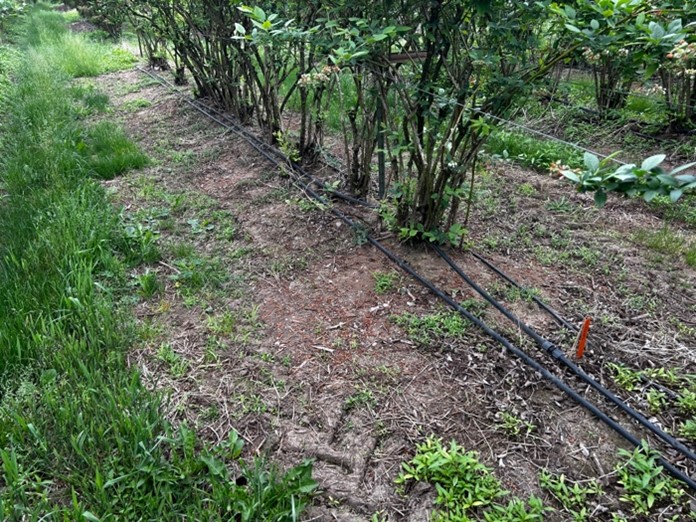Contributed by Marcelo Moretti and David King, Department of Horticulture, Oregon State University
Brake On! is a preemergence herbicide registered in blueberry and other horticultural crops in Oregon and Washington but not in California. Fluridone, the active ingredient of Brake On! inhibits carotenoid biosynthesis in the phytoene desaturase enzyme step. Plants treated with fluridone lack carotenoids, leading to rapid chlorophyll breakdown in tissue exposed to sunlight. Symptoms include plants producing new white tissue that eventually become necrotic. Fluridone is grouped in the WSSA mode of Action 12.
Brake On! controls broad leaves and grasses. Some controlled broadleaf species include annual sowthistle, willowherb, mallow, nightshades, prickly lettuce, knotweed, and puncturevine. The controlled grasses include annual bluegrass, barnyardgrass, crabgrass, and Italian ryegrass. Brake On! registration may help blueberry growers who are looking for an alternative to pendimethalin, while we work with manufacturers and regulatory agencies to reestablish pendimethalin registration in blueberries.
Important considerations when using Brake On!
- Apply Brake On! at 21 to 43 fl oz of product per acre.
- When using 32 fl oz or less, you must mix Brake On! with other preemergence herbicides. See the next section for recommended mixtures.
- Fluridone cannot be used for more than two consecutive seasons in the same field. We do not want to accelerate the selection of fluridone-resistant weeds.
- Brake On! can be used in newly planted blueberries after the soil has settled.
Brake On! performance in highbush blueberry
The Oregon Blueberry Commission funded the research presented here, which is ongoing. We initiated the study in December 2022 in a mature ‘Elliot’ field. Treatments were applied to the base of the plants and included a postemergence herbicide (glufosinate). The weather after the application was rainy and cold and weed germination was only observed after March 2023. As of spring 2023, smartweed predominates (See figures below). A mixture of Brake On! (32 fl oz/ac) with either rimsulfuron (Matrix 2 oz/ac) or flumioxazin (Chateau 6 oz /ac) provides the best weed control we have observed to date.

1. No preemergence herbicide check. Five months after postemergence treatment.

2. Brake On! (32 fl oz/ac) plus pendimethalin. Five months after treatment.

3. Brake On! (32 fl oz/ac) plus rimsulfuron (Matrix 2 oz/ac). Five months after treatment.

4. Brake On! (32 fl oz/ac) plus flumioxazin (Chateau 6 oz/ac). Five months after treatment.
Take-home message
Brake On! is safe for highbush blueberries and can help control some problematic weed species. It will also be a valuable tool in managing herbicide-resistant populations of Italian ryegrass and annual bluegrass, as no cases of resistance to herbicide in this group have been documented in the Pacific Northwest. Remember not to treat the same field with Brake On! for more than two consecutive seasons. Our suggestion is to use Brake On! at 32 fl oz/ac in mixtures with Matrix or Chateau during the dormant season in highbush blueberry.
Acknowledgment: This work was funded by the Oregon Blueberry Commission.